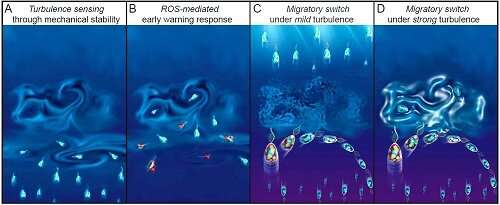Figure 1. Reactive oxygen species (ROS) levels mediate early warning system of motile phytoplankton in face of hydrodynamic turbulence. Shown here are cells of different ROS levels (reddish hue indicates a high ROS level), as a result of exposure to turbulent cues simulated in the lab. In weak and mild turbulence, phytoplankton resort to ROS-mediated adaptive migration; while under strong turbulence conditions, motility is switched off, resulting in lasting impacts on biological fitness and photosynthetic efficiency. Credit: University of Luxembourg
Physicists from the University of Luxembourg, together with scientists from Sweden, Israel and Switzerland, have established mechanistic links between physiological stress and migratory behavior in aquatic photosynthetic microorganisms in the face of turbulence.
Phytoplankton, aquatic microorganisms that teem our lakes and oceans, are indispensable in holding our ecosystem in balance, more so during the rapidly shifting patterns we encounter in our environment today. Crucially, as primary producers, phytoplankton convert energy from the sunlight into organic carbon, positioning themselves critically at the base of the aquatic food webs. Yet to date, we lack a mechanistic understanding of how emerging turbulent landscapes—a consequence of changing climate—impact phytoplankton behavior and fitness.
The ground breaking results, published in this week's edition of the Proceedings of the National Academy of Sciences, provide unprecedented insights into the fate of the marine microorganisms through changing climatic conditions.
Turbulence is stressful, but the plankton seem prepared
Phytoplankton are microscopic photosynthetic organisms which form the base of most aquatic food webs, regulate the global biogeochemical cycles, and by transferring CO2 from the atmosphere to the oceans, produce half of the world's oxygen. As discussed in a recent talk at the TEDx University of Luxembourg event, many species of phytoplankton are motile and often migrate in response to gravity: upwards toward light during the day, and downwards at night, toward higher inorganic nutrient concentrations. In doing so, cells are exposed to varying levels of hydrodynamic turbulence. Turbulence has long been known to drive phytoplankton fitness and species succession: motile species dominate in calmer environments and non-motile species in turbulent conditions. Yet a mechanistic understanding of the effect of turbulence on phytoplankton physiology and migratory behavior has been lacking so far.
Microbial SOS: An exquisite biomechanical early warning system
Prof. Anupam Sengupta, ATTRACT Fellow and head of the Physics of Living Matter Group at the University of Luxembourg, has now led an international team of scientists from Sweden, Israel and Switzerland, to bridge this long-standing gap in marine microbial ecology. By combining techniques in physics, fluid mechanics and microbiology, Prof. Sengupta and his colleagues have quantified the accumulation of physiological stress—measured by fluorescence labeling of Reactive Oxygen Species (ROS) in phytoplankton—as they get swirled around in a specially designed whirlpool that mimics ocean turbulence (see the ocean-in-lab technique in action here). The authors reveal the mechanistic link by mathematically modeling the experimental data, linking physiological stress with the swimming statistics. The novel results demonstrate an exquisite biophysical mechanism whereby phytoplankton integrate the turbulent cues over time via stress signaling, and then harness their biomechanical stability for sensing the intensity of turbulent cues, to ultimately trigger adaptive migratory behavior (Figure 1). The work follows from Prof. Sengupta's pioneering discovery, reported earlier in the journal Nature (Sengupta et al., Nature 2017), that nearly 50% of motile phytoplankton species adapt to turbulence by rapid diversification of migration strategies.
Anticipating species survival in a changing climate
Emerging climatic trends are altering the hydrodynamic landscapes of our oceans and lakes, thus impacting microbial behavior, survival and global primary productivity. By linking turbulence—an unavoidable environmental perturbation—to photosynthetic efficiency and biological fitness, this work advances our ability to predict long term ramifications of climate change by accounting for the global feedbacks between modified ocean currents and plankton-mediated primary productivity. With his team of cross-disciplinary scientists, Prof. Sengupta is currently studying phytoplankton species—both motile and non-motile—under more realistic settings, where cells experience a combination of both biotic and abiotic stressors, in addition to turbulence.
"This will allow us to capture ecologically relevant scenarios, and understand how these tiny marvels of nature adapt to their dynamic environments. The discovery of the stress-mediated early warning strategy will prove consequential to understand how phytoplankton species cope (or crash) as turbulence attributes alter, and thus shed light on which species will successfully proliferate—including those which we observe in our local water bodies in Luxembourg—as we experience changing climatic conditions," explains Prof. Sengupta.
More information: Francesco Carrara et al. Bistability in oxidative stress response determines the migration behavior of phytoplankton in turbulence, Proceedings of the National Academy of Sciences (2021). DOI: 10.1073/pnas.2005944118
Journal information: Nature , Proceedings of the National Academy of Sciences
Provided by University of Luxembourg
























